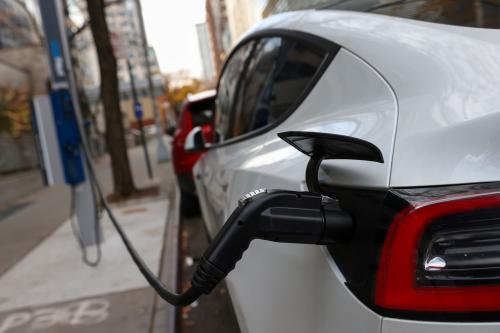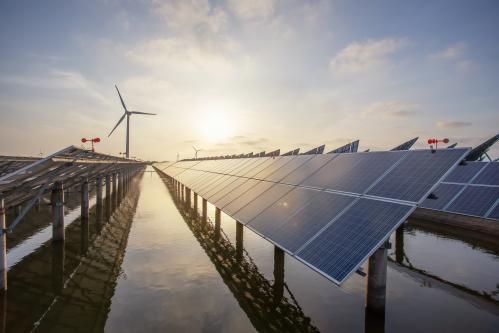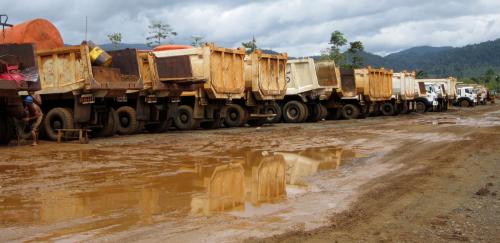

Past Event
On May 19 and 20, the Center for Hydrogen Fusion Power at New York University’s Courant Institute of Mathematical Sciences and the Brookings Institution co-sponsored the conference Hybrid Fusion Systems: What Can They Do and Can They Do It Soon. The conference considered the role of current and near-term energy future technologies in the larger energy environment and the current regulatory picture. Presenters explored interdisciplinary topics such as: fusion, fission, and hybrid systems, waste treatment, non-proliferation, and regulation.
Specifically, the conference examined two key questions: Can hybrid fusion-fission systems deal with the used fuel (“waste”) from nuclear fission reactors? And, can such a system be developed in a reasonable amount of time? Agreement was broadly reached among some 28 scientists and engineers that such a fusion-fission program might work and could help solve the nuclear waste problem, while generating significant additional energy.
Speakers included: Andrew Kadak, a professor of nuclear engineering at MIT; Kathryn McCarthy, Idaho National Laboratory; Eric Storm, Lawrence Livermore National Laboratory; and Michael Zarnstorff, Princeton Plasma Physics Laboratory. Also in attendance will be Steven Fetter, assistant director at-large at White House Office of Science and Technology, and the University of Maryland’s Roald Sagdeev, who is former director of the Soviet Space Institute in Moscow.
Background
A typical nuclear reaction operates by splitting heavy atoms, usually a specific isotope of uranium, by hitting an atom with a neutron. Some of the neutrons cause splitting with a subsequent release of energy, but others are absorbed by the uranium causing that uranium to be transmuted into other elements that cannot be split (in a conventional reactor) and thus creating a radiotoxic “waste”. The energy that is released by this splitting is collected and then used to make electricity. These reactors are called “critical” fission reactors, because when uranium atoms in the proper configuration are split, one of the byproducts is several more neutrons which can do more splitting and hence carry on the reaction in a self-sustained manner. Of course, such a “critical” reaction must be controlled so that it does not become an atomic bomb, but it does not need an external source of neutrons to operate.
When a uranium fuel rod is used in a fission reactor only a small fraction of its available energy content is extracted. If the used fuel rod (the “waste”) could be made inert, perhaps by further “splitting,” (with a generous source of energetic neutrons), we could solve the problem of waste disposal and generate additional energy. These splitting reactors convert long-lived radioactive atoms into shorter-lived ones (thus reducing the hazard of the material) but they do not produce enough neutrons to proceed in a self-sustained manner. These are “subcritical” reactors and require an external (separate) neutron source for their operation. The “waste burning” procedure produces roughly 25% as much additional energy as was produced in the original utility reactors.
The dream of “fusion energy” is to combine hydrogen atoms to make helium, just like the sun, with virtually endless clean energy. This is probably a distant goal, but such reactions, even at lesser power, do produce neutrons, and these neutrons can be used to drive a subcritical fission reactor.
If the nuclear waste could be wrapped around a low-power fusion reactor, the fusion neutrons could be used to split (“burn up”) the used fuel and make more energy at the same time. This is the essence of the hybrid fusion-fission reactor: a subcritical “blanket” of fissionable material surrounding a lower-power fusion reactor used to generate energetic neutrons. Hybrid Fusion Systems: What Can They Do and Can They Do It Soon discussed whether this might work and how soon.
Hybrid Systems
It was generally agreed that the significant steps to be taken entailed engineering and materials advances more than scientific breakthroughs. There are various sorts of fusion devices and it is not clear which will work best in this hybrid scenario. Nor is it yet clear which device can be built economically in a reasonable time frame. How long this will take to do is as much a function of our interest and resolve as it is a function of scientific and technological breakthroughs. Work at this Conference showed that a hybrid system, with appropriate choices (of fuel cycles, for instance), may provide a significantly cheaper way to deal with used fuel than competing technologies which have been studied and found to be very expensive. This is because preliminary computations show that while it might take 35 “fast reactors” to dispose of the waste from our 104 presently operating reactors, the same job could probably be done with 4-6 hybrid systems.
Hybrids will undoubtedly be more expensive to build but we may need far fewer of them.
Effectively dealing with nuclear waste also means we help minimize the problem of proliferation. Proliferation worries stem, in part, from the fact that pure plutonium (a very dangerous bomb-grade material) can be chemically extracted from used nuclear fuel. If a viable way to treat used fuel existed, a country wishing to set up nuclear generation of electricity could purchase fuel rods from us (thus saving a large start-up cost) and we could take back the used fuel to treat the waste. In this manner that country would never have the used fuel from which to extract plutonium. This very idea has recently been advanced by Russia to Serbia.
Just six days after the close of this Conference, Secretary of Energy Stephen Chu was asked, in an interview for the MIT magazine Technology Review, for his perspective on managing the roughly 50,000 metric tons of nuclear waste stored at some 130 sites across the country, now that the Yucca Mountain storage facility has effectively been cancelled. He replied “we’re looking at reactors that have a high-energy neutron system that can actually allow you to burn down the long-lived actinide waste. These are fast neutron [fission] reactors. There are others, a resurgence of hybrid solutions of fission fusion where the fusion would import not only energy, but again creates high-energy neutrons that can burn down the long-lived actinides.”
Conclusions
A key conference outcome was that a robust research and development program to explore the practicality of these ideas and to pursue the engineering and materials challenges is needed. This R&D program will select which sort of fusion reactor is best-suited to this process. Although this selection will make a particular lab or group of scientists the “primary contractor” for the fusion device, it is clear at the outset that there will be enough high-level development work to keep all interested parties busy.

Dana R. Fisher
February 13, 2024

Rayan Sud, Sanjay Patnaik
September 28, 2022

Rodrigo Castillo, Lilly Blumenthal, Caitlin Purdy
September 21, 2022